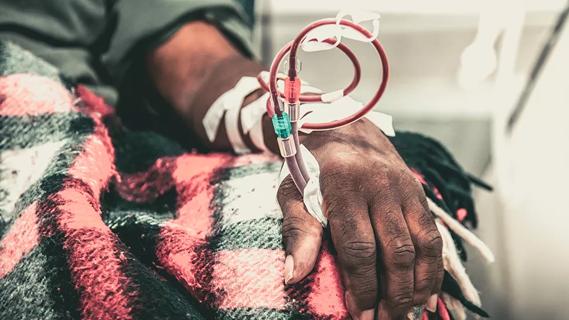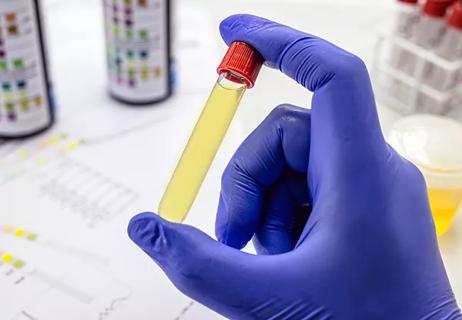The team reports their early experience and what's ahead

Cleveland Clinic physicians Tushar Vachharajani, MD, interventional nephrologist and Director of Interventional Nephrology and Eduardo Mireles-Cabodevila, MD, critical care physician and Director of the Medical Intensive Care Unit, are reimagining the dialysis vascular access strategy in an acute care setting.
Advertisement
Cleveland Clinic is a non-profit academic medical center. Advertising on our site helps support our mission. We do not endorse non-Cleveland Clinic products or services. Policy
Dr. Vachharajani presented the team’s early experience with this new model of care, delivering tunneled dialysis catheters (TDCs) in the medical ICU, at the American Society of Nephrology’s Kidney Week 2021. The abstract highlights the team’s early experience with the first 120 TDCs and small-bore-related procedures.
Of these 120 initial cases, 27 included placement in patients with COVID-19. The procedure was performed on patients with dual organ failure (liver and kidney) and often with coagulopathy. The team is still investigating best practices to deliver care safely to this complex patient population.
They are currently evaluating the utility of a thromboelastography test to aid in the safe placement of TDCs in patients at high risk of bleeding. Additionally, a training and competency criteria have been established.
Conventionally, acute hemodialysis therapy in the ICU is initiated by intensivists with a temporary non-tunneled dialysis catheter placed at the bedside. However, explains Dr. Vachharajani, “If the anticipated need for dialysis therapy is beyond seven to 10 days, a tunneled dialysis catheter (TDC) is preferred over a non-tunneled catheter to minimize the risk of blood stream infection and catheter dysfunction, which can result in sub-optimal dialysis treatment.”
Early transition to TDC in the critically ill population can be challenging for a multitude of logistical reasons. As such, the Medical Intensive Care Unit and Interventional Nephrology teams at Cleveland Clinic established a collaborative service to place TDC and other small bore tunneled central venous catheters in the ICU setting.
Advertisement
Early in the coronavirus pandemic, delivering TDC efficiently while also minimizing the risk of exposure became critical. This was particularly germane given the high incidence of acute kidney injury in patients with severe cases of COVID-19.
The placement of TDC is time- and resource-intensive; it requires a specialized procedure room or an interventional radiology suite with access to fluoroscopy to guide catheter placement, per the National Kidney Foundation’s Kidney Disease Outcomes Quality Initiative (KDOQI) guidelines. It also involves coordination among different clinical and patient transport teams, which poses a greater risk for viral spread.
The physicians developed a protocol to guide internal jugular TDC placement at the bedside without compromising patient safety. The placement is done under the direction of an experienced provider using ultrasound guidance, continuous cardiac monitoring and anatomical landmarks.
An early pilot study using this approach in 10 patients with COVID-19 was presented at the World Congress of Nephrology in Canada in 2020 and published in the Kidney International Reports, establishing its safety and effectiveness in select patients.
Since then, the team has placed a total of 425 tunneled central venous catheters with 120, nearly one-third, at the bedside – in patients with and without COVID-19.
The collaboration between interventional nephrology and critical care services leverages skill sets from both disciplines. Says Dr. Mireles-Cabodevila, “The interventional nephrologists are experts on how and when to place the long-term catheter while the intensivists manage acute care. This partnership truly represents a new paradigm in care for our patients.”
Advertisement
Dr. Vachharajani says they have also begun cross-training efforts, enabling critical care physicians to place TDC; they have also developed a regional training center.
Though bedside placement of TDC began as a COVID-era innovation, the physicians agree that with the appropriate resources, it’s a best practice in select patients.
“We are seeing highly selected, high-risk patients benefit from getting a long-term catheter earlier and without having to move them out of intensive care units,” says Dr. Vachharajani.
Advertisement
Advertisement

Authors summarize the recent evidence and offer two clinical scenarios

Key considerations when diagnosing and managing severe hyponatremia

Clinicians should individualize dosing practices based on patient risk factors and preferences

Fully-automated process uses preop CT, baseline GFR to estimate post-nephrectomy renal function

Could mean earlier treatment, but also could have negative effects

Identifying barriers in the renal genetic assessment of Black patients

Getting patients to their goal blood pressure

Study highlights benefits of nephrologist-led urine sediment analysis